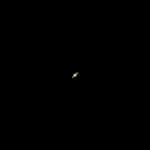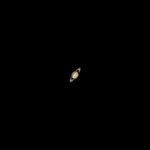Saturn is the sixth planet from the Sun and the second-largest in the Solar System, after Jupiter. It is a gas giant with an average radius of about nine and a half times that of Earth. It has only one-eighth the average density of Earth, but is over 95 times more massive.
Saturn’s interior is most likely composed of a rocky core, surrounded by a deep layer of metallic hydrogen, an intermediate layer of liquid hydrogen and liquid helium, and finally, a gaseous outer layer. Saturn has a pale yellow hue due to ammonia crystals in its upper atmosphere. An electrical current within the metallic hydrogen layer is thought to give rise to Saturn’s planetary magnetic field, which is weaker than Earth’s, but which has a magnetic moment 580 times that of Earth due to Saturn’s larger size. The outer atmosphere is generally bland and lacking in contrast, although long-lived features can appear. Wind speeds on Saturn can reach 1,800 kilometres per hour.
The planet’s most notable feature is its prominent ring system, which is composed mainly of ice particles, with a smaller amount of rocky debris and dust. At least 83 moons are known to orbit Saturn, of which 53 are officially named; this does not include the hundreds of moonlets in its rings. Titan, Saturn’s largest moon and the second largest in the Solar System, is larger (while less massive) than the planet Mercury and is the only moon in the Solar System to have a substantial atmosphere

